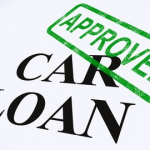Why A Seven Year Auto Loan Might Be A Bad Choice
April 14, 2014 Jordan L Bourland Leave a comment
The contemporary mentality for most loans, including auto loans, is to ask yourself whether or not you can afford the payment. This is a good start; it’s important to be sure that the monthly payment fits into the household budget and won’t cause undue financial hardship. On the other hand, this mentality neglects the other half of the equation: the total cost of the loan. The principal of the loan remains the same- it’s the price of the car. However, the longer term of the loan means that you are paying interest for a longer time and potentially paying much more over time.
The Bank’s Perspective
When a bank or dealership offers you a loan to finance a car purchase, they need to be worried about the risk of default- the risk that at some point you stop paying back the loan. The bank is essentially buying the car and hoping that you pay back the money. Think about the difference between a five year loan and a seven year loan from the bank’s perspective. Under a seven year loan, the bank’s money spends an additional two years tied up in the car, with the return uncertain. That’s another two years during which you could stop paying back the loan, for whatever reason. The bank needs to charge a higher interest rate on long term loans in order to feel comfortable enough to issue the loan.
Numerical Example
Let’s imagine that you are seeking a loan for a $16,000 car. You get a quote from the bank on two different loans. One of them is a five year option with a monthly payment of 301.94 and an interest rate of 5 percent. The other is a seven year loan with a monthly payment of 241.8 and an interest rate of 7 percent.
Which loan is a better deal?
The five year option has a higher monthly payment by about sixty bucks, or about one cup of coffee per day for the month. But that isn’t the whole story. When the five year loan is over, you will have paid a total of $18,116.40 for a car you paid $16,000 and has since accumulated five years of depreciation. Under the seven year plan, you pay $20,284.32 total and the car has seven years of depreciation before the loan is over. That’s over two thousand dollars more. In other words, skipping that one cup of coffee a day saved two thousand dollars and got you out of debt two years faster.
The Equity Trap
When you buy a car with a loan, you have zero equity- you owe exactly as much as the car is worth. But as soon as you actually drive the car off the lot, it loses as much as 20 percent of its market value. That means you actually have negative equity – if you tried to sell the car as soon as you left the dealership, you would not be able to pay off the whole loan with the money you made from the sale.
Depreciation hits cars hard. Taking a shorter loan will allow you to regain equity in the car faster, because you pay down the debt faster than the car depreciates. It won’t take long to get back to zero equity and then positive equity with a five year loan, as compared to a seven year one, because the seven year term is slower at cutting down the debt you owe.
Life Changes
Five years is a long time, and seven is even longer. What are the odds that you will move or have a kid in five years? Whatever the odds are, they are higher for seven years. The seven year term is an extra two years’ worth of life events that might make the car you bought unfit for your current situation. Worse, in those extra two years you might experience a catastrophe that makes it impossible to pay back the loan at all, which can put you at risk for default and ruining your credit. Two extra years is not just extra risk for the bank- it’s extra risk to you as well. The sooner you get that debt off the books, the better, because it eliminates the threat of default and frees you up to find a new car.
Reselling a Car
You know about depreciation. But have you thought about it in the context of selling an old car to buy a new one? It might feel odd to think about a car you are buying now as a potential old car, but it will happen. At some point, you will need to buy another car. The current one will wear down or need to be upgraded or just doesn’t fit your family anymore. When that happens, the length of time you have had your car affects its market value. No amount of good upkeep will make a seven year old car as valuable as a five year old one.
A seven year loan term commits you to that car for seven years before it is totally yours. That’s seven years of wear and tear and potential major repairs. The extra two years affects the resale value of the car negatively. That will make it harder to sell the car and use its value towards a new one. The problem gets worse if you need to sell the car before the end of the loan, because it will both be worth less and the amount of the loan remaining will be bigger, relative to a five year loan. So under a seven year loan, you will be left with more debt if you need to sell the car prematurely.
The Risk Problem
The two key takeaways for comparing long loans against short ones is that first, a long loan is a higher debt burden that will wind up costing you more, and second, a longer loan means more risk. There’s a reason the bank charges more interest for a longer loan. It really is a bigger risk to hold a loan for that extra time, no matter how rosy things look now. Consider the economy. A person needs to hold a job for five years in the current job market to ensure they can make their steady payments every month. Under a seven year term they have an additional two years- almost half again as much time- in which they need to hold onto their jobs. Of course, you don’t expect to lose your job. But there are literally millions of Americans today who are out of work. They didn’t expect to lose their jobs, either. It just happened. They might have car payments, too. That’s the kind of risk that a short loan minimizes.
The Bottom Line
Valley Auto Loans is always looking out for our customers. We don’t want anyone to bite off more than they can chew when it comes to auto loans. We strongly endorse getting short term loans. Yes, this will make the monthly payment larger, in just about every case. But that monthly payment is not an indicator of the true burden of the loan.
If you can’t find a car for which you can get a five year loan at an acceptable monthly payment, consider examining less expensive cars or late-model used cars, which can offer significant savings without compromising on features. Remember that 20 percent loss of value on a car as soon as it comes off the lot? You can take advantage of that on the buying side. In any case, think of it this way.
The first thought that comes into peoples’ heads when they consider a car loan is “Can I afford the payment?” The real thing you need to consider is “Can I afford the loan?” The payment is a short term cost. The whole cost of the loan involves much bigger numbers- thousands of dollars just in interest costs hang in the balance.
Why A Seven Year Auto Loan Might Be A Bad Choice by Jordan L Bourland
Share the post “Why A Seven Year Auto Loan Might Be A Bad Choice”
Recommended for you
Post navigation
Previous PostThe Key to Negotiating the Best Trade-In Value for Your CarNext PostGuaranteed Auto Loans vs Bad Credit Auto Loans

 Guaranteed Auto Loans vs Bad Credit Auto Loans
Guaranteed Auto Loans vs Bad Credit Auto Loans What To Know About Co-Signing a Bad Credit Auto Lo…
What To Know About Co-Signing a Bad Credit Auto Lo…